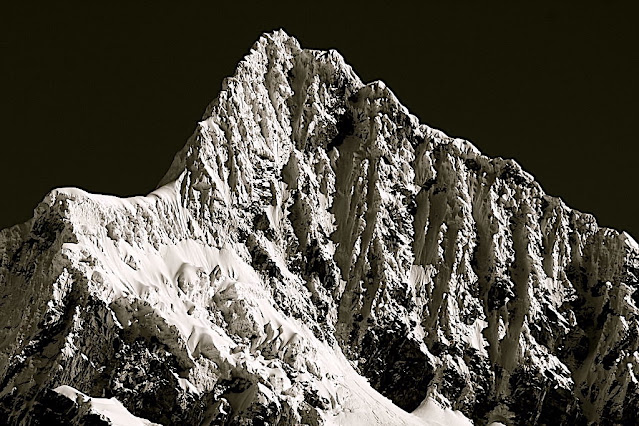Jebel Toubkal (4,167 m - 13, 671 ft)
Morocco
In Atlas mountains viewed from Marrakech, oil on canvas, 1949.
Jebel Toubkal (4,167 m - 13, 671 ft) is
the high point of the High Atlas as well as Morocco and North Africa .
It is located 63 km south of Marrakech, in the province of Al Haouz,
inside the national park that bears its name.
The word Toubkal would be a deformation of French origin of the same Amazigh name Tugg Akal or toug-akal which means "the one who looks up the earth". The
people of this region still use this name. The Toubkal massif is made
up of rocks of various natures. Dark rocks of volcanic origin are found
on the summits of andesite and rhyolite. Glaciers have left
characteristic marks of their passage in the form of valleys in trough.
During the Würm glaciation, the present valley of Assif n'Ait Mizane
was occupied by the longest glacier in the Atlas, about 5 km long.
The climate at Jebel Toubkal is mountainous. The snow falls in winter and covers the summit.
In the nineteenth century, the interior of Morocco was still terra
incognita for the Europeans and for a long time the Jebel Ayachi (3,747 m
-12,293ft) ) passed for the highest summit of the High Atlas. In fact,
the Toubkal was officially climbed for the first time only on 12 June
1923 by the Marquis de Segonzac, accompanied by Vincent Berger and
Hubert Dolbeau. The cairns which they found on the summit had been built
by the Berbers of the environs for whom the Toubkal is a holy place
dedicated to Sidi Chamarouch (or Chamharouch). A sanctuary is dedicated
to him on the way from Imlil to Toubkal.
The ascent of the roof of North Africa attracts a large number of
followers of the trekking. This ascent attracts the crowd as much as it
does not present great technical difficulties and that the assistance of
the muleteers and their mules reduces the physical efforts. The
altitude is relatively high (3,200 meters at the shelter and 4,167
meters at the summit).
The artist
Winston Leonard Spencer-Churchill was forty before he discovered the
pleasures of painting. The compositional challenge of depicting a
landscape gave the heroic rebel in him temporary repose. He possessed
the heightened perception of the genuine artist to whom no scene is
commonplace. Over a period of forty-eight years his creativity yielded
more than 500 pictures. His art quickly became half passion, half
philosophy. He enjoyed holding forth in speech and print on the
aesthetic rewards for amateur devotees. To him it was the greatest of
hobbies. He had found his other world -- a respite from crowding events
and pulsating politics.
Encouragement to persevere with his hobby stemmed from an amateur prize (his first) which he won for "Winter Sunshine, Chartwell" a bright reflection of his Kentish home. He sent five paintings to be exhibited in Paris in the 1920s.
Modesty shone through that self-estimate. Modesty - and warm sympathy
--were undeniably evident in what Churchill told a fellow painter,
Sergeant Edmund Murray, his bodyguard from 1950 to 1965. Murray had been
in the Foreign Legion and the London Metropolitan Police. Interviewing
him to gauge his suitability, Churchill said: "You have had a most interesting life. And I hear you even paint in oils." After Murray had his work rejected by the Royal Academy, Churchill told him: "You know, your paintings are so much better than mine, but yours are judged on their merit."
Churchill's progressive workmanship demonstrates that a pseudonym
employed at a crucial stage shrewdly enabled him to find out where he
stood before moving on to fine-tool his talent.Churchill again favoured a
pseudonym (Mr. Winter) in 1947 when offering works to the Royal
Academy, so his fame in other spheres was not exploited. Two pictures
were accepted and eventually the title of Honorary Academician
Extraordinary was conferred on him. He earned it. That is borne out by
the conclusion of the renowned painter Sir Oswald Birley: "If
Churchill had given the time to art that he has given to politics, he
would have been by all odds the world's greatest painter." Connoisseurs
of Sir Winston's art stoutly defend their individual preference, but
there are convincing arguments for bestowing highest praise on "The Blue Sitting Room, Trent Park" which was sold in 1949 to aid charity.
Despite outward flippancy, Churchill had a true craftsman's dedication
when he took up a paint brush. He consulted teachers admired for their
professionalism. He was fond of citing Ruskin's Elements of Drawing and
readily accepted Sir William Orpen's suggestion that he should visit
Avignon, where the light can verge on a miracle. He recalled an
encounter on the Côte d'Azur with artists who worshipped at the throne
of Cezanne and gratefully acknowledged the inspiration he derived from
their exchange. Marrakech, Morocco -- irresistible and productive --
always brought out the best in him.
Churchill sought and found tranquillity in his art. His much quoted
words, summing up expectations of celestial bliss, retain their lustre: "When
I get to heaven I mean to spend a considerable portion of my first
million years in painting, and so get to the bottom of the subject..."
___________________________________________
2022 - Wandering Vertexes...
by Francis Rousseau
%20-%20Atlas-mountains-Oukaimeden%20the-view-from-Marrakesh-1949.jpg)
%20%20-%20Leo%20Wehrli%20et%20Carlos%20Bruckdevant%20le%20%20%20Volcan%20Planchon%20(1897),%20Colorie%CC%81%20par%20Anna%20M.%20Wehrli-Frey-%09%20ETH%20Library%20%20Zurich%20%20.jpg)

%20grayday-%20Green%20land%20Iceberg%20Alaska%20%20.jpg)

.jpg)


%20Summit%20of%20Fuji%20Series-%20Ten%20Views%20of%20Fuji-%20Woodblock%20Print.png)
,%201837-1908%20Rolfe,%20W.%20J.%20(William%20James),%201827-1910-Astronomy_for_the_use_of_schools_and_academies_(1882)Copernicus%20crater-%20Library%20of%20Congress.jpg)
_%20Rocky_Landscape_in_the_Elbe_Sandstone_Mountains_%201822--.jpg)
-%20Les%20Eaux%20Bonnes%20dans%20les%20Pyre%CC%81ne%CC%81e%CC%81es%20vers%201840%20Lithographie%CC%81%20par%20J.%20Kernot%20-%20Pic%20du%20midi%20d'OSsau%20.jpg)

-%20Nuptse%20%20Himalaya%202011%20%20acrylic%20on%20paper-%20John%20Mitchell.jpg)


